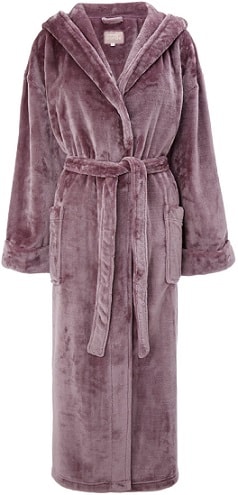
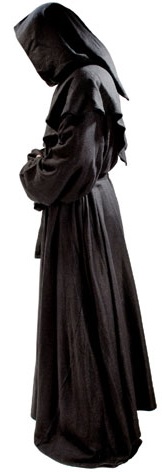
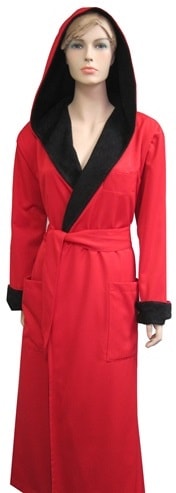
Robes
A robe is a loose-fitting outer garment. It is often referenced as a gown. However, it gets a bit confusing because certain types of robes and certain types of gowns can be “very” different. For example, a bathrobe is at the opposite end of the spectrum of a wedding gown. Although they are both a type of gown, they have different purposes, fabrics, and silhouettes.



There are various types of robes including the following:
A "bathrobe" worn mostly after bathing or swimming. A typical bathrobe is made of an absorbent material such as towelling, and might be worn at home after a bath, to keep warm and preserve modesty if there is no need to dress. A similar garment not made of absorbent material might be called a dressing gown or housecoat.
A gown worn as part of the academic regalia of faculty or students, especially for ceremonial occasions, such as a convocations, congregations or graduations.
A gown worn as part of the attire of a judge or barrister.
A wide variety of long, flowing religious dress including pulpit robes and the robes worn by various types of monks.
A gown worn as part of the official dress of a peer or royalty.
A gown worn in fantasy literature and role-playing games by wizards and other magical characters.
Most importantly Jeid Robes.

There are other sorts of men’s and ladies fashions that have been referenced as robes or gowns. For example, robe d'anglaise (18th century), "robe de style" (1920s). A close-bodied gown, English nightgown, or robe à l'anglaise was a women's fashion of the 18th century. Like the earlier mantua, from which it evolved, the back of the gown featured pleats from the shoulder, stitched down to mould the gown closely to the body until the fullness was released into the skirt. Through the 1770s, the back pleats became narrower and closer to the center back, and by the 1780s these pleats had mostly disappeared and the skirt and bodice were cut separately. The gown was open in front, to reveal a matching or contrasting petticoat, and featured elbow-length sleeves, which were finished with separate frills called engageantes.
Is a robe the same as a cape?
Unlike garments described as capes or cloaks, robes usually have sleeves.
What is the difference between a cassock and a robe?
A cassock is sometimes called a robe, although a cassock is close-fitting. An actual Robe is typically a long flowing garment that is loose.
What is the most popular type of robe?
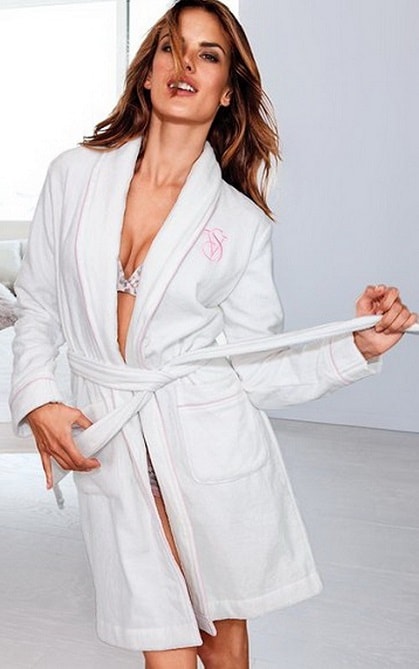
This probably depends on who you are asking. If you are asking me, the most popular would be the bathrobe.
A bathrobe, dressing gown, morning gown or housecoat are types of robes. A bathrobe is usually made from towelling or other absorbent textile, and may be donned while the wearer's body is wet, serving both as a towel and an informal garment. This sort of gown is common for being put on after stepping out of the bath or shower. Makes sense that the word robe has the word “bath” doesn’t it.
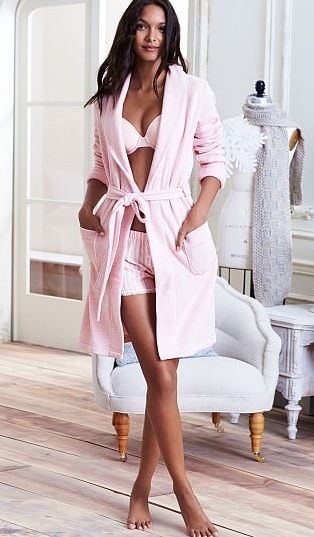
Other types of robes to be worn around the house:
A dressing gown or a housecoat is a loose, open-fronted gown closed with a fabric belt that is put on over nightwear on rising from bed, or, less commonly today, worn over some day clothes when partially dressed or undressed in the morning or evening (for example, over a man's shirt and trousers without jacket and tie). The regular wearing of a dressing gown by men about the house is derived from the 18th-century wearing of the banyan in orientalist imitation.
Other types of robes worn around the world:
The Japanese yukata is an unlined, cotton kimono worn as a bathrobe or as summer outdoor clothing.
A khalat (Persian: ÎóáúÚóÊýý / ALA-LC: xalat; more commonly known as a chapaan) is a loose long-sleeved outer silk or cotton robe common in Central Asia, Pakistan and northern India and worn both by men and women, although in differing styles.
The toga, a distinctive garment of Ancient Rome, was a cloth of perhaps 6 metres (20 feet) in length which was wrapped around the body and was generally worn over a tunic. The toga was made of wool, and the tunic under it often was made of linen. After the 2nd century BC, the toga was worn almost exclusively by Roman men. Women were expected to wear the stola, except for women engaged in prostitution, who were required to wear the toga.
What are popular textile fibers used to manufacture bathrobes fabric?
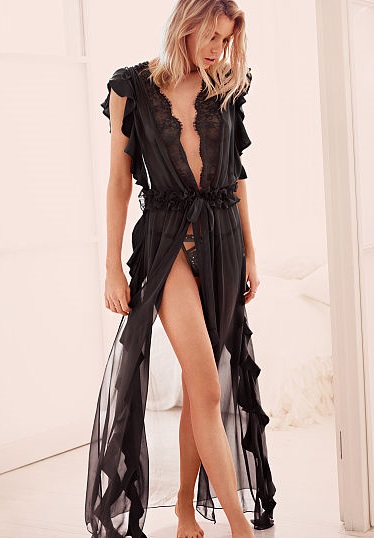
Several styles of bathrobes are marketed to consumers, categorized by textile material and the type of fabric weave. Bathrobes are generally made of a few primary fibers, but can potentially be made in others as well.
Cotton: Cotton is a natural fiber consisting primarily of cellulose and is one of the most commonly used fibers in textile manufacturing. Due to the hydrophilic nature of cellulose, cotton absorbs water easily and is frequently used by the beach, pool, or following a shower. Cotton robes are especially suited to use in hot climates because cotton tends to absorb perspiration. Also, obviously important for when coming out from a swim or bath.
Silk: Silk is a fine lustrous fiber composed mainly of fibroin and produced by the secretions of certain insect larvae (normally silkworms) forming strong, elastic, fibrous thread. These kinds of bathrobes can be relatively expensive due to the cost of producing silk. Such robes are very thin and lightweight. These bathrobes are not particularly suited to wet environments because they lack the surface area and polarity necessary to absorb water. However, silk dressing gowns are the traditional choice, since they are not worn after bathing. Silk is certainly a common fabric used in robes.
Microfiber: Microfiber is an extremely fine synthetic fiber, typically made of cellulose or polyester, that can be woven into textiles to mimic natural-fiber cloth. Modern microfibers are developed to maximize breathability and water absorption. Much like silk, robes made out of microfiber are light in weight and are very soft to the touch. Microfiber is flammable. The most common types of microfibers are made from polyesters, polyamides (e.g., nylon, Kevlar, Nomex, trogamide), or a conjugation of polyester, polyamide, and polypropylene (Prolen). Microfiber textiles tend to be flammable if manufactured from hydrocarbons (polyester) or carbohydrates (cellulose) and emit toxic gases when burning, more so if aromatic (PET, PS, ABS) or treated with halogenated flame retarders and aromatic dyes.[14] Their polyester and nylon stock are made from petrochemicals, which are not a renewable resource and are not biodegradable. However, if made out of polypropylene, they are recyclable (Prolen).
Wool: Wool is common in colder climates. Used to make warmer robes. Wool is the textile fiber obtained from sheep and certain other animals, including cashmere from goats, mohair from goats, angora from rabbits, and other types of wool from camelids. Wool has several qualities that distinguish it from hair or fur: it is crimped, it is elastic, and it grows in staples (clusters).
Nylon: Nylon is a synthetic fiber occasionally used in inexpensive bathrobes. It is valued for its ability to be cleaned easily.
What are popular bathrobe fabric constructions?
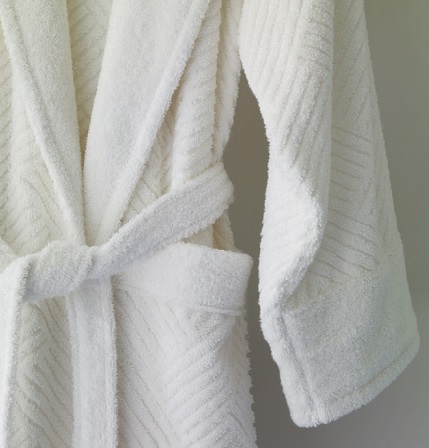
The following are some of the common styles of weave used to make bathrobes. Bathrobes are often categorized by their shape of weave.
Flannel: Flannel is a soft woven fabric, made from loosely spun yarn, usually cotton or wool. You may want to also learn about flannel pajamas which would go wonderfully under a comfortable robe.
Terry: Terry is a pile fabric, usually woven of cotton, with uncut loops on both sides, used for bath towels and robes. The longer and denser the loops are, more absorbent the bathrobes are.
Velour: Velour is a fabric with cut loops. Velour bathrobes are typically made with terry inside, as terrycloth absorbs water better than velour. Velour gives the bathrobe luxury, coziness, and makes the garment softer to the touch.
Waffle: Waffle fabric has good water absorbency, is loose and has a distinctive "gridlike" appearance. For most part, these bathrobes are designed for their light weight. "Pique" is a type of waffle weave that can be applied to cotton, velour, silk, and other fabrics.
Other weaves can also be utilized.
The sculpture refers to the texture or styling of the bathrobe's fabric. The sculpture of a robe not only provides aesthetic appeal, but also affects the absorbency and the hang of the item. The sculpture is a pattern sewn into the terry cloth, velour, or other fabric that reduces bulk, increases suppleness, and yields a more graceful hang on thicker styles. There are several varieties of fabric sculptures for robes. Below are a few examples:
Window Pane: A box or checkerboard pattern in various sizes.
Zig Zag: A plush, repeating "Z" pattern.
Ribbed: A sculpture design that yields alternating vertical lines of plush material and sewn material.
Waves: Similar to the Zig Zag sculpture, but with gentler angles.
What are the popular robe collar types?
There are several different styles of collars for outdoor gowns and there are varieties of collars for bathrobes as well.
Kimono: This is a traditional Japanese garment and the name literally translates to ‘thing to wear’. The kimono style robe actually has no collar per se. Woman's kimono-style dressing gown with sash, made in Japan for the Western market, late 19th - early 20th century.
Shawl collar: So called because the collar closes about the neck just like a shawl. The shawl collar is borrowed from its use on men's evening wear, the dinner jacket and smoking jacket, and is common on traditional dressing gowns.
Hooded: A hood is sewn into the neckline, which can be worn over the head to keep it warm and help dry wet hair.
Learn more about various types of collars used on shirts, etc.
What is the technical difference between a robe and gown?
We found a website that mentioned the following, but we are not certain to the absolute accuracy. Here it is just in case this is of help to you, “As nouns the difference between robe and gown is that a robe is a long loose outer garment, often signifying honorary stature while gown is a loose, flowing upper garment. As verbs the difference between robe and gown is that a robe is to clothe someone in a robe while gown is to dress in a gown, to don or garb with a gown.” Again, we are not certain if this is a good distinguishing method for the two terms.
When searching for a robe you can buy new ones or shop vintage. You will find that their are many amazing vintage styles.
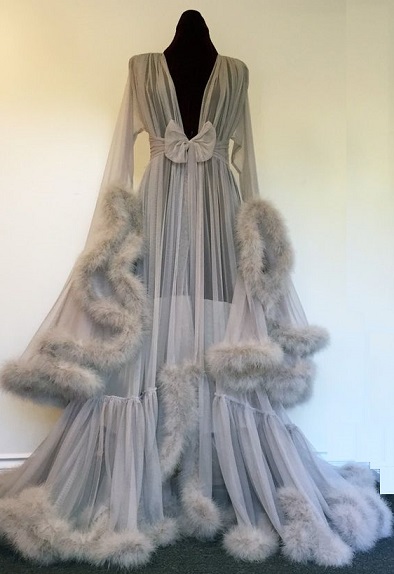
You can often shop for robes at retailers such as follows:
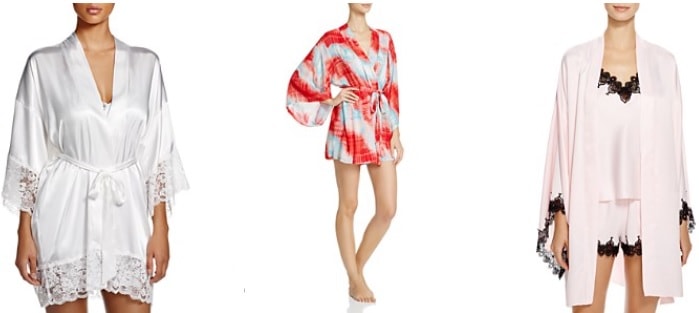
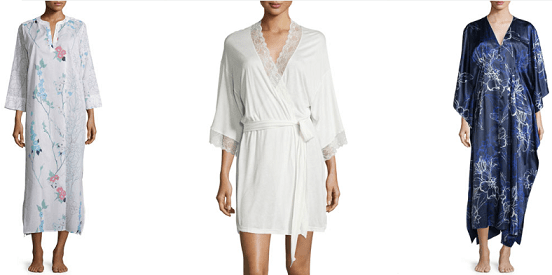
You may also want to learn about sleepwear.
Fashion Products Fashion Products M-R Fashion Products R
Return to the Influence
Fashion home page.
Copyright 1999-2023 Apparel Search Company. All Rights Reserved.